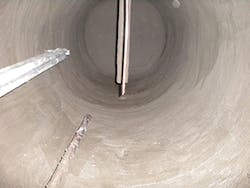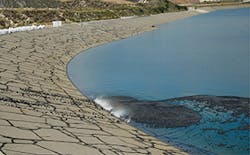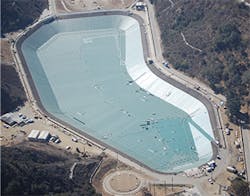A 49-year-old water storage tank leaking water eventually led the town of Chapmanville, WV, to replace its 75-year old water distribution system in 2015. Eventually, it learned that the town’s distribution lines were also leaking like sieves. Together, the distribution lines and leaking storage tank were losing more than half of the town’s water due to the leaks.
Jerry Workman, Chapmanville Water Department’s system manager, says the oldest of the three tanks, built in 1949, had a hole at the bottom of a wall. A robot an investigator sent into the tank revealed a lot of pitting and a floor that was rusted out, he says.
This deteriorating tank proved to be a lesson in the importance of preventive maintenance. Workman says he did not recall the previous manager providing any maintenance to the tanks. After he took over the management of the department in 2006, he did some maintenance on the tank. But when he discovered the leak, he went to the Chapmanville Water Board and asked for funding to replace it.
An engineering study by Robinson Engineering Co. found more than 10,000 linear feet of cast iron water lines that had been in place for more than 60 years needed replacing.
This water storage tank, shown above before and after
rehabilitation by Amtech Tank Lining, is used for potential
fire suppression. It was lined with DuraChem, manufactured
by Poly Lining Systems, a sister company of Amtech.
A $3-million rehabilitation project, partially funded through the Environmental Protection Agency’s Drinking Water State Revolving Fund, was completed in 2015. The project included replacing the 1949 tank, plus one other that was badly corroded—both 100,000 gallons—with a single 218,000-gallon tank. The third tank was refurbished.
The West Virginia Drinking Water Treatment Revolving Fund provided a $1.5 million loan for the rehabilitation project. Another $1.5 million was provided through a Small Cities Block Grant from the US Department of Housing and Urban Development.
Workman says the department is now doing regular maintenance under a program required by the West Virginia Health and Human Services Department as a condition of receiving state funding.
ACCIDENT LEADS TO LEAK
Rob Pearlman, a senior engineer at Amtech Tank Lining & Repair, is an expert on all types of liquid containment tanks, and specifies procedures for lining steel, concrete, and fiberglass vessels. He says that different problems affect steel tanks, concrete tanks, and fiberglass tanks.
“Steel tanks have superior structural strength and some resilience, but can be susceptible to surface corrosion and spot pitting, and concrete tanks are usually constructed to have superior structural characteristics but can spall and crack. While fiberglass tanks are impervious to these issues, for the most part,” he says, “they are more likely to see problems like damaged corrosion coats, affecting the thin interior layers which actually contain the liquids. The rest of the tank’s mass is the composite system that makes it stand there and look like a tank.”
Small incidents such as a screwdriver scratch inside a fiberglass tank or a topside pump or agitator part falling into a tank being worked on can damage the thin corrosion coat and lead to liquid product eventually migrating into the structural body of the tank. Depending on the contained liquid, corrosive action can also degrade the corrosion coat. “When our fiberglass division gets a call that the area around a nozzle or manway, or the floor/body junction knuckle is weeping product, we know right off that the liquid may be entering the body of the tank 2 feet up and 3 feet to the left, and through hydrostatic pressure and capillary action, find the path of least resistance to make its exit.”
George Mead, municipal sales director for Tank Connection says bolted or welded steel tanks provide the advantage of a zero leakage tolerance. The smoothness of the welded steel structure reduces maintenance costs. Concrete tanks are allowed some tolerance for leakage as described below under standards for “Water Tightness.”
Contamination will become an issue if owners don’t keep up maintenance of vents on the roof of the water tank. The risk is that the water line that pumps water to the distribution system may then introduce the contamination into that system. If owners carry out a water tank maintenance program every three to five years, contamination won’t be a problem, Mead says.
WASTEWATER TANK COVERS SAVE ENERGY
Joel Portman, president of United Tank Systems, says roofs prevent rain water from getting into wastewater tanks. “The water treated in digester/clarifier tanks takes on volume when rain water is added to the tanks.” If there are 22 inches of precipitation, he says, this will add one-half million gallons to the digester process that wouldn’t be needed and this adds costs.
Portman also observes that there is no way of knowing what water is lost in underground tanks. It would show up as unknown water loss in a water audit.
On June 9, 2008, the Los Angeles Department of Water and Power began covering Ivanhoe Reservoir with over 3
million shade balls to aid in maintaining water quality. They are a temporary solution and will remain until a new reservoir, now under construction, is completed and operational. The 96 million shade balls installed at the Los Angeles Reservoir in 2015 will be permanent because the reservoir is too large for a single floating protective cover.
RESERVOIR COVERS CONSERVE WATER
Water loss in reservoirs is due primarily to evaporation. Steve Roades, vice president of Burke Industries says water is expensive and it evaporates. And lining the reservoir prevents water from leaking into the soil. The company designs, fabricates, and installs flexible geomembranes for reservoirs. The geomembranes are made of CSPE—chlorosulfonated polyethylene—brand name Hypalon.
Putting a geomembrane on a reservoir or a roof on a water tank will prevent contamination. The Clean Water Act required that all open top reservoirs have covers by the year 2000. With a geomembrane on a reservoir, water can come directly to the tap, Roades asserts.
Roades says costs for flexible membranes are up to 65% less than rigid structures. Beyond 10 million gallons, membrane costs become significantly less—a drop from a membrane for a small tank at $1.50 per gallon to $0.50 per gallon for a tank over 10 million gallons.
Leaks in membranes don’t happen from wear. In a power point presentation, Roades reports that the covers and liners of the Happy Valley Reservoir in Australia were replaced due to a diver tearing the liner while cleaning it. The original covers and liners had been in place for 26 years and 28 years in two storage reservoirs.
Roades says leaks in reservoir covers do happen and 95% of the time they are vandal-related. Storms are another cause. In the first instance, prevention involves keeping kids out of the area, for example with fencing, says Roades, adding that repairs are the solution to tears.
Vandalism can be deterred by creating an environment in which the risk of detection is too great—for example with lighting. Tamperproof fencing and security patrols can also deter intruders.
SHADE BALLS
The Los Angeles Department of Water and Power covered four of its reservoirs with shade balls to temporarily comply with federal water quality mandates. Federal regulations require reservoirs containing treated drinking water to be covered and shade balls don’t qualify.
However, the Los Angeles Reservoir, the most recent to be permanently covered with shade balls in 2015, will disinfect the water as it leaves the reservoir. It is 175 acres and would have required two floating covers costing $300 million according to Richard Harasick, LADWP’s director of water operations speaking with Southern California Radio Station KPCC in August 2016. The municipal utility achieved savings of $250 million by choosing shade balls at a cost of $34.5 million. Each shade ball that was spread over the water surfaces cost 36 cents.
Shade balls were rolled out on three smaller reservoirs starting in 2008 on Ivanhoe Reservoir, February 2009 on Elysian Reservoir, and April 2012 on Upper Stone Canyon Reservoir. But they were not a permanent solution. Ivanhoe’s and Upper Stone Canyon’s shade balls will be removed in 2017 and Ivanhoe will be taken out of service. Elysian Reservoir’s shade balls were removed recently. It and Upper Stone Canyon will be covered with floating covers in 2017.
The 4-inch, spherical black balls have cut annual evaporation losses off the water surfaces 85% to 90%, saving about 300 million gallons of water. By reducing the water surface area exposed to the sun, water quality is protected by preventing sunlight-triggered chemical reactions and controlling the formation of algae blooms and bromates. The wind flow is also reduced above the water surface.
The shade balls are made of food-grade, high-density polyethylene (HDPE) resin with a black colorant that inhibits ultra-violet light degradation. The material and production process has been certified by NSF International and complies with federal and state standards including the California Department of Drinking Water and US Environmental Protection Agency’s Stage 2 Disinfectants and Disinfection Byproducts Rule.
Each of the shade balls used on the Los Angeles Reservoir weighs 40 grams and is filled with 200 grams of drinking water to give it weight so it is not blown away in the high-gust area where it is located. The shade balls used at the other three reservoirs are hollow and are not filled with water. The shade balls have a service life of at least 10 years and will eventually lose structural integrity. They will then be removed and recycled.
PREVENTIVE MAINTENANCE IS KEY
Leakage from a water system’s storage tanks is referred to as physical loss, but before it is detected it could be considered non-revenue water—water that is not billed and no payment is received. Any water leakage represents costs to the water system through the additional energy and chemical usage required to treat the lost water. A water loss control program thus becomes critical for any utility.
A water audit is the first step in a water loss control program. An audit identifies and quantifies the water uses and losses from the water system. The second step is intervention through implementing controls to reduce or eliminate water losses. The third step is evaluation to determine the success of the chosen intervention action.
It is rare that a water leak in a storage tank would be detected during a water audit, since the tools to identify leaks are designed to internally inspect mains and distribution lines and to evaluate metering. Therefore, regular water tank maintenance programs are better suited to identify water leakage in storage tanks.
Most, if not all, tank manufacturers recommend tanks be inspected one year after being painted for the first time or repainted. Then they can be inspected every three to five years, says Chip Stein, with Tank Industry Consultants.
The Los Angeles Department of Water and Power’s Lower Franklin Storage Reservoir in Beverly Hills, CA, received a new floating cover in February 2017.
During the first one-year inspection, Stein says to look for premature failures. Before any significant corrosion can occur, spot clean the areas that have failed, then apply a coating to that area. Stein says it is important to spot these problems early in the corrosion state when it is more cost effective to repair.
However, if the failure becomes more widespread than just isolated spots, the economics flip and repairs become much more expensive, Stein says. As coatings come close to the end of their lives, he recommends speeding up inspections to three years.
To extend the lifetime of the coating system and improve water quality, Matthew Tasch, with Superior Tank Solutions recommends that a company be brought in every year to do a simple inspection, and every two to three years do an in-depth inspection and make repairs. Tanks are getting more expensive to replace and taking care of them is less expensive.
If you don’t inspect a tank on a regular basis, any coating could be jeopardized says Mead. In Kentucky, he says, a glass-lined bolted steel tank failed because of lack of maintenance. Welded and bolted tanks have had catastrophic failures, he adds. He recommends that all owners and utilities should drain the tank and physically inspect it inside after the first year and again every three to five years.
Normally, the independent engineer overseeing the design of a new tank will specify that it should be inspected 12 to 14 months after installation. Performing inspections also aids in maintaining the warranty, which could range from one to five years, depending on the specifications requirements. The best inspections occur when the tank is empty, Mead says.
Tank coatings can break down for numerous reasons and can lead to leaks. Mead has seen a bullet hole in a tank, which subsequently led to coating failure inside the tank, which in turn led to rust development. In colder climates, ice can form inside the tank, which can harm the coatings on the internal sidewall. If the water is “turned over” or used at a rate that minimizes ice buildup, the water should not freeze inside the tank. The design should suit the needs of the population being served and not be oversized, but should also allow the water to circulate through cold seasons, he says.
The inside of a water tank is the most important part to maintain properly, says Davies Hood, with Induron Coatings. The atmosphere inside is more hospitable to corrosion—it’s damp, wet, and because the water is always fluctuating, some areas are dry. The moisture and the chemicals in the water like chlorine increase the likelihood of corrosion.
The first area that corrodes is the roof, Hood explains. Above the water line the tank walls are exposed to oxygen, creating an opportunity for corrosion. Ladders, angles, and edges are the most difficult to paint and the first to rust.
Hood says the industry standard to address this issue is a brush-applied seam coat—a coat of paint and mechanical action of the paintbrush gets paint into the seams and protects them. An additional coat should go over the seam coat.
Epoxy linings with no VOCs or hazardous air pollutants (HAPs) are excellent barrier coatings for steel. “The thicker the materials, the longer they last,” he says.
WHAT DO THE STANDARDS SAY?
The American Water Works Association’s (AWWA’s) standards for storage tanks are virtually accepted by all manufacturers. Here are extracts from AWWA’s M42 manual highlighting the testing and evaluations that should be done during the construction of a new water storage tank and for inspecting operating water tanks. For the details and more extensive discussions, the M42 manual is available on AWWA’s website (www.awwa.org).
TESTING
Once a steel tank bottom is completely welded, and before it is painted, it should be tested for water tightness using any of the following methods: magnetic-particle testing, air-pressure or vacuum testing, or shell-to-bottom joint testing.
The owner may ask the builder of a bolted steel tank to test the joints of the steel bottom using the vacuum method before filling it with water. This involves brushing the seam with soap suds or linseed oil. A vacuum box is placed over the coated section of the seam and a vacuum is applied to the box using a connection to a gasoline or diesel engine intake manifold. Bubbles or foam produced by air sucked through the seam will identify a leak if it exists.
Once the tank is erected, it should be hydro-tested by filling the tank with water to the top capacity level. Any leaks found in the tank below the top capacity level should be repaired according to the manufacturer’s instructions.
With concrete and shotcrete tanks, service-load stresses should be limited to provide protection against leakage either into or out of the tank, and against corrosion of the reinforcement.
ROOF DESIGNS
Roof structures constructed of concrete, steel, aluminum, or fiberglass-reinforced plastic may be used if designed according to currently accepted standards. The design should provide a weathertight roof to prevent leakage and contamination of the water in the tank.
Concrete slab roofs should be reinforced to resist temperature and shrinkage stresses. The design should include crack control to prevent leakage and corrosion of the reinforcement.
Liquids should be prevented from leaking into non-prestressed cast-in-place or precast concrete slab roofs for potable water tanks by requiring a minimum slope of 1.5%. Alternately, a coating or membrane can be installed to prevent liquids from getting into the tank.
Another standard, ACI 350, applies to non-prestressed, steel-reinforced concrete flat slabs to manage crack control.
FLOOR DESIGN
Among other details, AWWA standards require that membrane floors for cast-in-place concrete tanks be a minimum 4-inches or 100-millimeters thick. And the floors shall be placed continuously in sections as large as practicable to decrease the length of construction joints and potential leakage problems. Long-term shrinkage effects should be taken into consideration with large floor sections.
When the tank is empty or when tank water levels are lowered during operation, adequate surface drainage should be maintained to avoid hydrostatic uplift. This can be accomplished with a perimeter drain around the tank wall foundation and underdrainage, if necessary.
To control cracks in the floor, the minimum reinforcement on the horizontal plain in each direction shall be at least 0.5% of the concrete area.
FOOTING DESIGN
Column footings shall be designed according to ACI 350, mentioned above, and may be an integral part of the membrane floor. If the column footings are separated from the floor, submerged joints have to be used, but they increase the potential for leakage. When footings are placed below the floor slab and integral with it, additional reinforcing may be required to control cracking caused by slab movement restriction due to concrete shrinkage or temperature changes.
Inverted footings placed above the slab will avoid this condition but may entrap sediment and impede normal washdown and cleaning maintenance.
WATER TIGHTNESS
Once the new tank has been completed, a test should determine water tightness before backfilling. Fill the tank with potable water to the overflow level, close all inlet, outlet, and drain valves and make sure they are not leaking. Let it all stand for at least 24 hours.
Measure the drop in liquid level over the next 72 hours to determine the liquid volume loss to compare with the allowable leakage. Calculate evaporative losses and deduct from measured loss to determine leakage. This should not exceed 0.05% of tank capacity. If it is determined there is leakage, the test should be extended to five days and if the average 24-hour leakage does not exceed the maximum allowable, the test is considered satisfactory. If the leakage exceeds the maximum allowable, the tank should be repaired, disinfected again, and retested.
If damp spots occur on the exterior of a concrete tank wall where moisture can be picked up on a dry hand, or if measurable leakage of flowing water at the wall base is seen, the source of this dampness should be located and permanently sealed in a manner acceptable to the tank owner.
LEAKS FOUND DURING ROUTINE MAINTENANCEExterior walls of water tanks already in operation should be examined regularly, and any leaks or rust streaking that could have been caused by leaks should be reported. A professional structural engineer familiar with water tank construction should inspect the tank as soon as possible after the leak is discovered. Potentially catastrophic tank failures can be avoided if the visible leaks are properly investigated and repaired.







